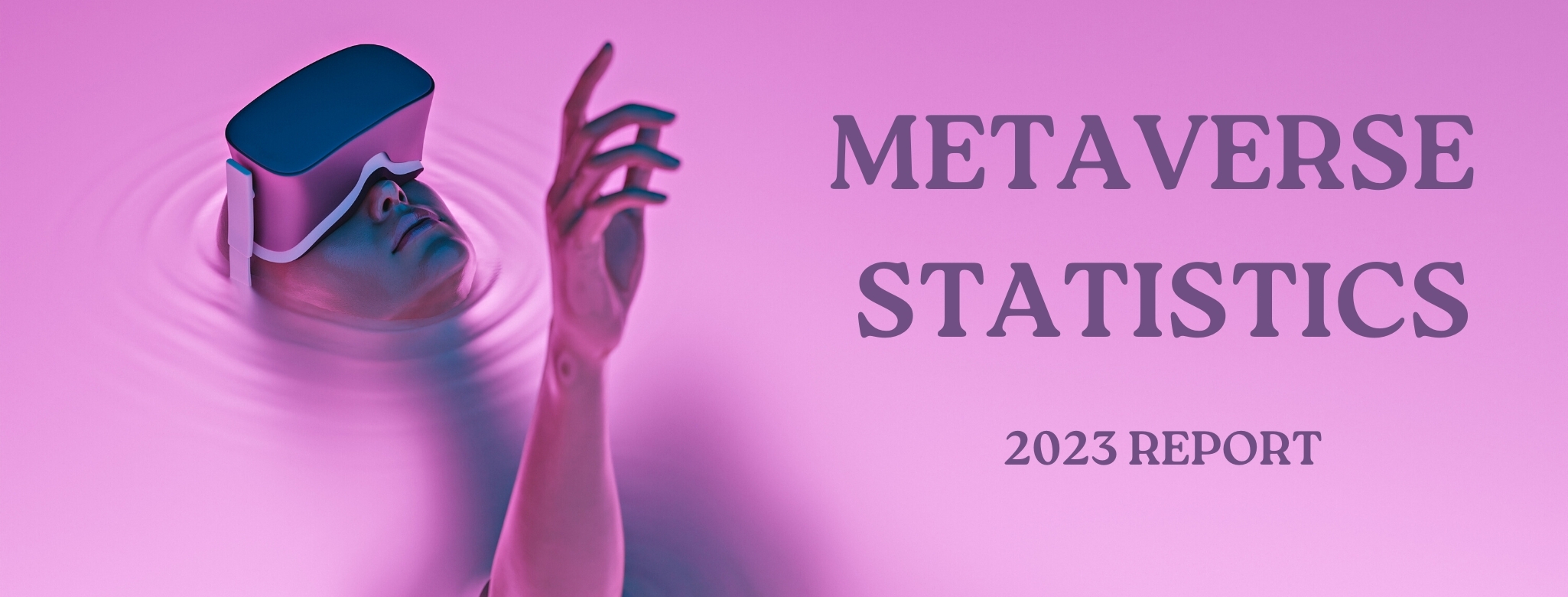
12 May TOP METAVERSE STATISTICS IN 2023
Metaverses continue to attract millions of users since their launch with platforms like Second Life and Habbo Hotel counting 64.7 million and 278 million respectively. These online communities offer users a chance to socialize, play games, and even build businesses. A recent study by Bloomberg found that metaverse users have increased by 30% over the past year. This growth is driven by variety of factors, including the increasing popularity of VR headsets and the launch of new metaverses such as Decentraland and Cryptovoxels.
In this report, we will take a closer look at the latest metaverse statistics. We will examine the demographics of metaverse users, explore how they are using virtual worlds, and consider the implications of these trends for the future of the metaverse. So whether you are a seasoned veteran of virtual worlds or a total newcomer, read on to find out everything you need to know about the state of the metaverse.
25 Top Metaverse Statistics in 2023
Metaverse Statistics #1: The global metaverse market size reached USD 63.08 Billion in 2021.
According to the data from Emergen Research, the global metaverse market size reached USD 63.08 Billion in 2021 and is expected to reach USD 1607.12 Billion in 2030, registering a CAGR of 43.3%. The significant growth trends of the industry are attributable to the ever-growing popularity of online gaming, social media platforms, and virtual reality (VR) technology. The advent of 5G technology is also playing a pivotal role in enabling high-speed data transmission, thus providing a major boost to market growth. Additionally, the outbreak of the COVID-19 pandemic has resulted in a sharp increase in the number of people working from home and spending more time online, which is another key factor driving market growth. Furthermore, initiatives taken by government organizations and leading companies to promote the use of VR technology for training and education purposes are also projected to create lucrative opportunities for market players over the forecast period.
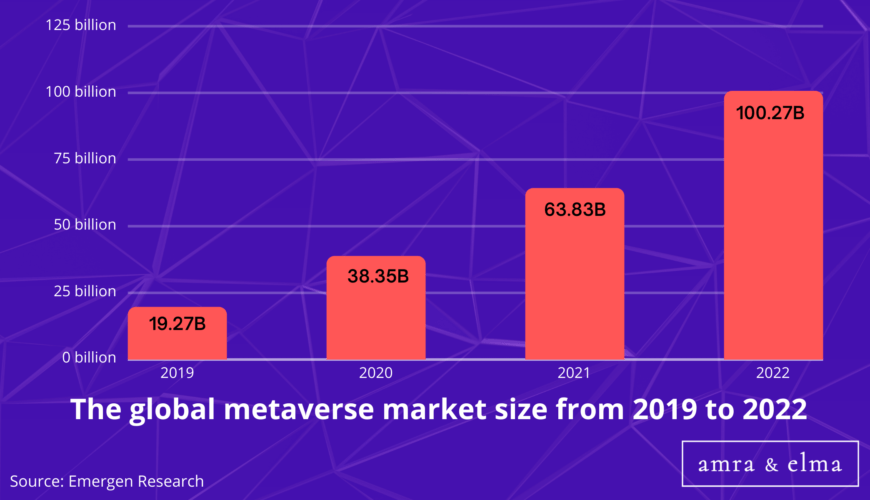
Metaverse Statistics #2: As of 2021, the total market capitalization of Web 2.0 metaverse companies was 14.8 trillion U.S. dollars.
According to Statista, as of October 2021, the total market capitalization of Web 2.0 metaverse companies was 14.8 trillion U.S. dollars. For gaming and eSports and also Facebook (now known as Meta after an October 2021 restructuring and pivot to VR), this figure sits much lower at 1.98 trillion and 0.90 trillion, respectively. Despite this difference, it is important to note that the total market capitalization for all three categories has been on the rise in recent years. For example, in October 2020, the figure for Web 2.0 metaverse companies was 12.4 trillion U.S. dollars. This represents a significant increase of 19 percent in just one year. Similarly, the market capitalization for gaming and eSports has grown by 21 percent and 34 percent, respectively, over the same time period. These trends suggest that there is strong interest in these areas and that they are likely to continue to grow in popularity in the years to come.
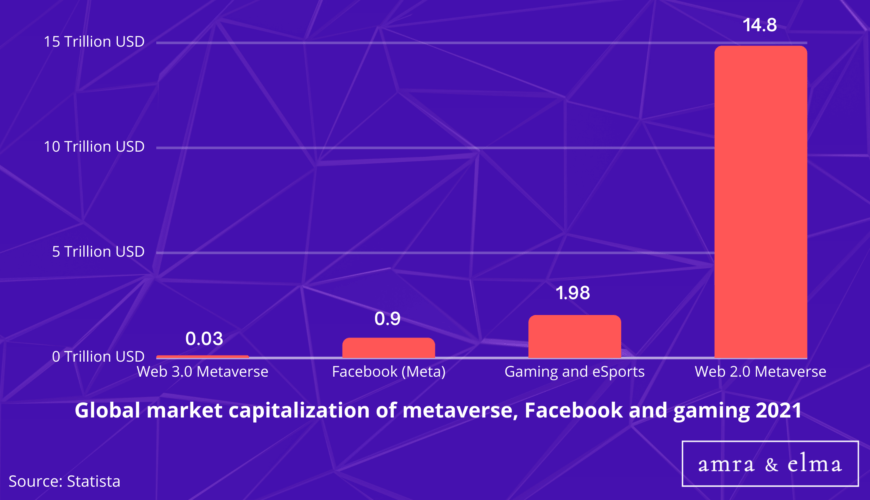
Metaverse Statistics #3: As of 2021, Web 3.0 virtual worlds had a grand total of 50,000 users around the globe.
According to Statista’s latest data on total number of users on virtual platforms, as of October 2021, Facebook was the leading virtual platform with a total of almost three billion users worldwide. In contrast, Web 3.0 virtual worlds had a grand total of 50,000 users around the globe. The significant difference in user base is attributable to a number of factors. Firstly, Facebook has been in operation for over a decade longer than most Web 3.0 platforms. Secondly, Facebook’s user base is primarily made up of individuals who are already accustomed to using social media platforms, whereas Web 3.0 is still in the early stages of adoption. Finally, Facebook has been investing heavily in virtual reality technology and content, positioning itself as a key player in the emerging metaverse. As more businesses and individual users begin to explore the potential of virtual reality, it is likely that Facebook will maintain its position as the leading platform provider.
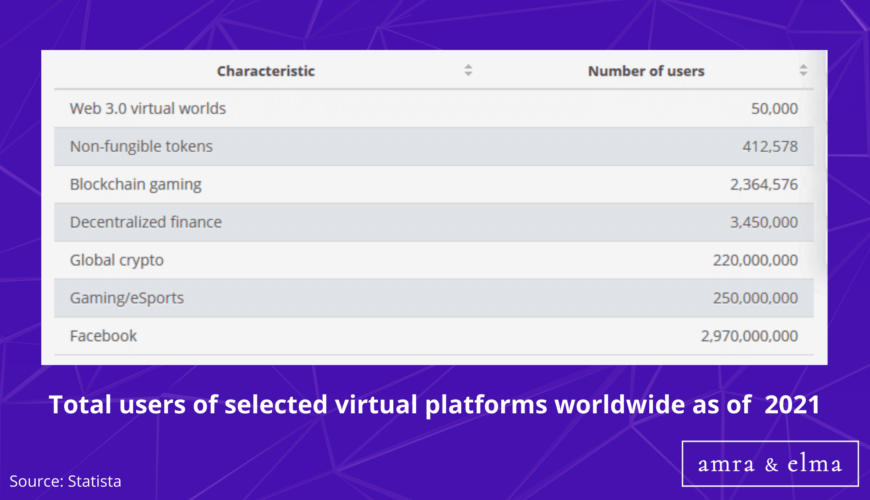
According to the data from EnterpriseAppsToday, as of 2021, North America accounts for the largest metaverse market share with 45.3%. This is followed by Asia-Pacific with 33.8% and Europe with 20.9%. The Asia-Pacific region is expected to grow at the highest CAGR during the forecast period. The increasing popularity of online games and online social networking among young people is a key factor driving the growth of the metaverse market in the APAC region. In North America, the United States is the major contributor to the metaverse market due to the presence of leading companies, such as Facebook, Cisco Systems, Microsoft, and IBM, which are investing heavily in research and development activities. These companies are also providing support for start-ups and small businesses to develop applications in the metaverse.

Metaverse Statistics #5: 36% of online adults in the United States are interested in using the Metaverse.
According to the recent survey by Statista, 36 percent of online adults in the United States were interested in using the Metaverse. Of this group, 12 percent reported to be very interested. The overall results showed that men were more likely to be interested in using the metaverse than women, with 18 percent of men saying they were very interested compared to seven percent of women. In addition, half of all women surveyed said they had no interest at all in using the metaverse. These findings suggest that there is still a significant gender divide when it comes to interest in virtual reality and the metaverse. However, it is worth noting that the survey was conducted in March 2022, and it is possible that these numbers could change as more people become familiar with the concept of the metaverse.
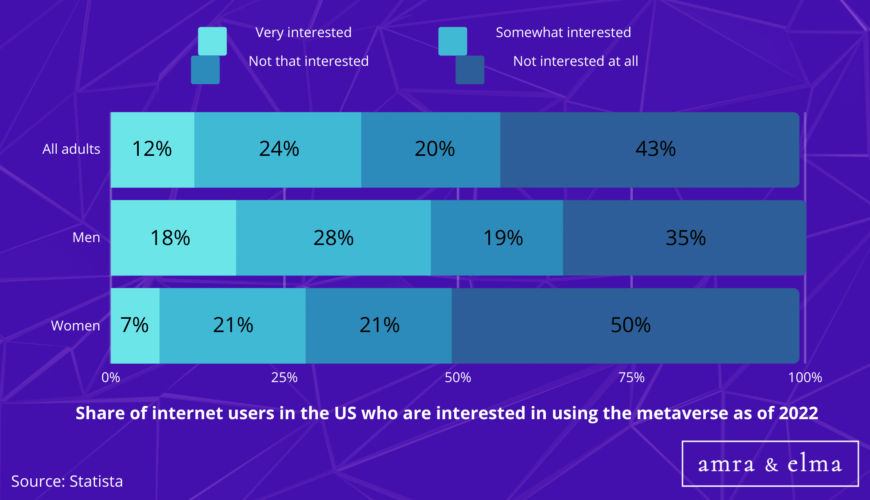
Metaverse Statistics #6: In 2022, 31% of surveyed adults in the United States said they had never heard of the metaverse.
According to the survey by Statista, as of January 2022, 31 percent of surveyed adults in the United States said they had never heard of the metaverse. Overall, just under one third of adults stated they had heard of the metaverse but were unfamiliar with it, and 14 percent reported to be very familiar with the metaverse. However, despite its relatively low awareness, the metaverse is expected to see rapid growth in the coming years. Many businesses are already investing in metaverse technologies, and it is widely predicted that the metaverse will eventually become a mainstream platform for commerce, entertainment, and communication. Thanks to its immersive and interactive features, the metaverse has the potential to revolutionize many industries and dramatically change the way we live and work.
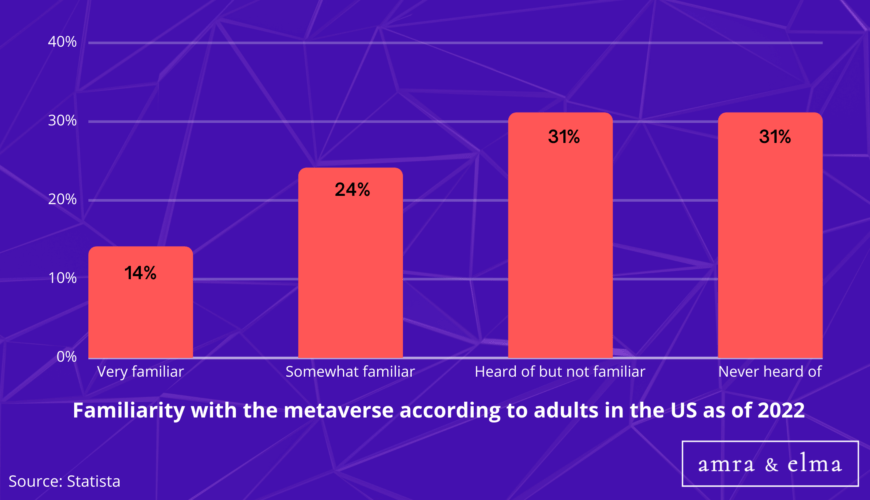
Metaverse Statistics #7: In 2022, 33% of U.S. Adults stated that they felt curious about the metaverse
According to a survey conducted in the United States by Statista in January 2022, 33 percent of respondents stated that they felt curious about the metaverse, whilst 27 percent said they were uninterested. Overall, almost a quarter of those asked reported feeling suspicious about the metaverse and 12 percent were confused. The results of the survey suggest that there is still some confusion about the metaverse amongst the general population. However, it also appears that people are becoming increasingly curious about this burgeoning online world. With more and more media coverage of the metaverse, it is likely that awareness and understanding of this virtual world will continue to grow in the coming months and years.
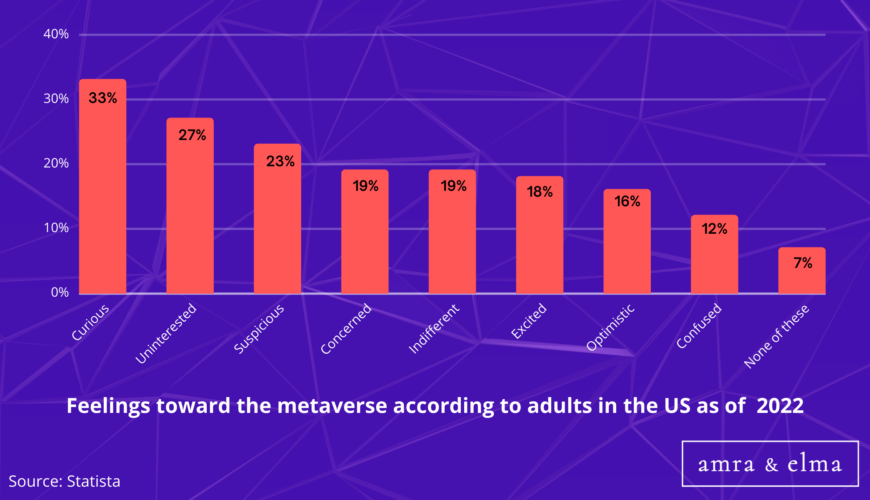
Metaverse Statistics #8: In 2022, 30% of surveyed adults in the U.S. said that metaverse will never be as good as real life.
According to a survey conducted by Statista, as of January 2022, 30 percent of surveyed adults in the United States said that an accurate description of their view of the metaverse was that it would not be as good as real life. Overall, 26 percent of respondents said that they viewed the metaverse as the future of technology and almost a quarter said that the metaverse was a new way for tech companies to figure out a way to make money. Additionally, 20 percent said they viewed the metaverse as a big risk to personal privacy. When broken down by age group, respondents aged 18-34 were more likely to view the metaverse as the future of technology, while those aged 35-54 were more likely to say that it was a new way for tech companies to make money. There was no clear consensus among respondents aged 55 and over. These findings suggest that there is still some uncertainty about the metaverse among the general public. However, it seems that younger people are generally more positive about its potential implications.
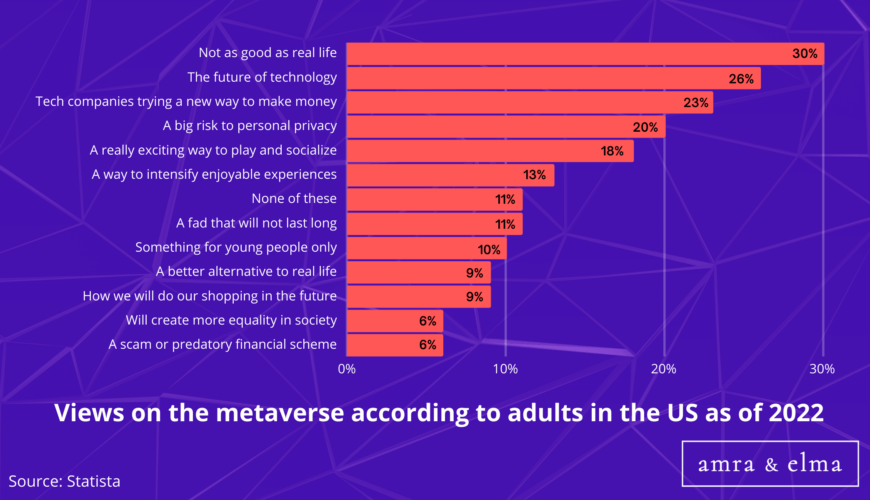
Metaverse Statistics #9: In 2022, 47% of the survey respondents perceive addiction to a simulated reality or virtual world as the biggest threat from the metaverse.
According to a survey conducted worldwide by Statista in 2022, nearly half of the respondents (47%) perceive addiction to a simulated reality or virtual world as the biggest threat from the metaverse. This is followed by problems related to privacy(41%) and mental health(41%). The study shows that people are concerned about the potential risks of spending too much time in a simulated reality, which could lead to addiction or mental health problems. The study also found that people are concerned about the potential for their personal data to be collected and used without their consent in the metaverse. These concerns indicate that there are some unintended consequences of the metaverse that users and society at large should be aware of.

Metaverse Statistics #10: In 2022, 55% of surveyed US adults reported that tracking and misuse of their personal data was a major Metaverse concern.
According to an online survey conducted in the US in March 2022, the most significant worry for internet users regarding the metaverse was the safety of their personal data. Overall, 55 percent of respondents reported that tracking and misusing their data were significant concerns. Online abuse and cyberbullying ranked second, with 44 percent of respondents saying this issue was considerable concern. In contrast, 40 percent of internet users stated that the environmental impact of energy consumption was not a concern at all, and 41 percent said they were also not worried about motion sickness from VR headsets. While it is understandable that people are concerned about their safety online, it is encouraging to see that people are not as worried about the environmental impact of the metaverse. Hopefully, as the technology improves, these concerns will lessen, and people will be able to enjoy the many benefits of the metaverse without fear.
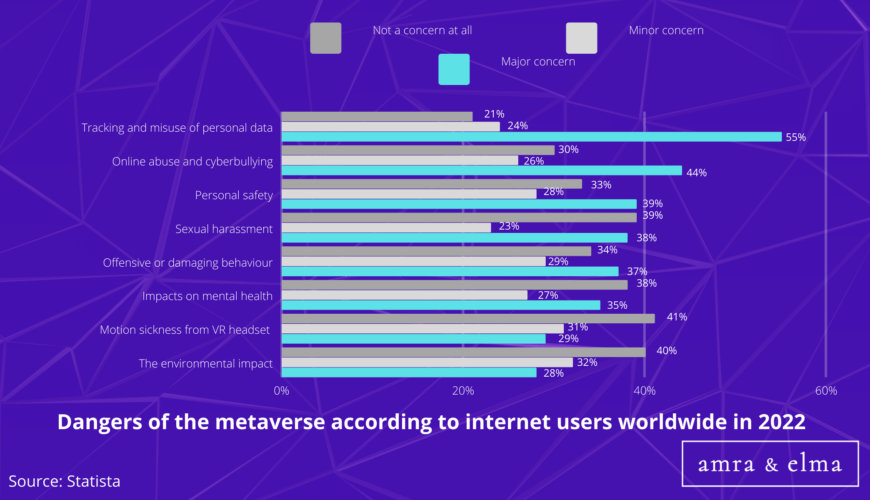
Metaverse Statistics #11: In 2021, 39% of global internet users stated that overcoming obstacles that prevented them from doing something in real life was biggest benefit of the metaverse.
A late 2021 survey of global internet users on Metaverse benefits, found that overcoming obstacles that prevented them from doing something in real life was perceived as the biggest benefit of the metaverse. Enhancing creativity and imagination was ranked second with 37 percent of respondents claiming this as a benefit. The metaverse also holds promise for upskilling, education, and exploring new career opportunities. In a world where physical limitations no longer apply, people will be able to acquire new skills and knowledge without having to leave their homes or jobs. For example, someone who wants to learn how to pilot a plane could do so in a virtual reality simulation, without ever setting foot in an aircraft. Similarly, people will be able to explore careers that they may never have considered if not for the existence of the metaverse. With the ability to try out different occupations in a safe and controlled environment, people will be able to make informed decisions about their future career paths. In addition, the metaverse provides a unique opportunity for businesses to reach new markets and customers. By creating virtual versions of their products and services, businesses will be able to tap into a global customer base without incurring the costs associated with traditional brick-and-mortar stores. As the metaverse continues to evolve, it is clear

Metaverse Statistics #12: In 2022, 74% of adults in the U.S. said that they were going to join or were considering joining the metaverse.
A recent survey suggests that the majority of adults in the United States are interested in joining the metaverse. The metaverse is a digital universe that people can explore and interact with using avatars. It is often compared to the virtual world in the movie Ready Player One. The survey found that 74 percent of adults are either considering or planning to join the metaverse. The most popular reason for wanting to join is to experience things that are not possible in physical reality (41 percent). Other reasons include the belief that the metaverse could be a positive way to unite people (38 percent) and the desire to become a different person other than their real self (23 percent). The survey highlights the growing interest in the metaverse and suggests that it could become a major part of our lives in the future.

Metaverse Statistics #13: In 2022, 552 apps included the keyword “metaverse” in their description.
According to a research from Statista, as of February 2022, of the 552 apps that included the keyword “metaverse” in their description, 144 did so in conjunction with the keyword “crypto.” NFTs was the second most popular topic referred to by apps mentioning the metaverse, with 118 apps reporting both keywords. Only 73 and 55 apps referring to the metaverse also mentioned AR and VR, respectively. The trend seems to suggest that while crypto and NFTs are becoming increasingly popular topics in the context of the metaverse, AR and VR are not seeing as much interest. This could be due to a variety of factors, such as the relative newness of AR and VR technology or the fact that they are not as well-suited for use in a digital world. Whatever the reason, it is clear that crypto and NFTs are currently leading the way in terms of popularity within the metaverse.
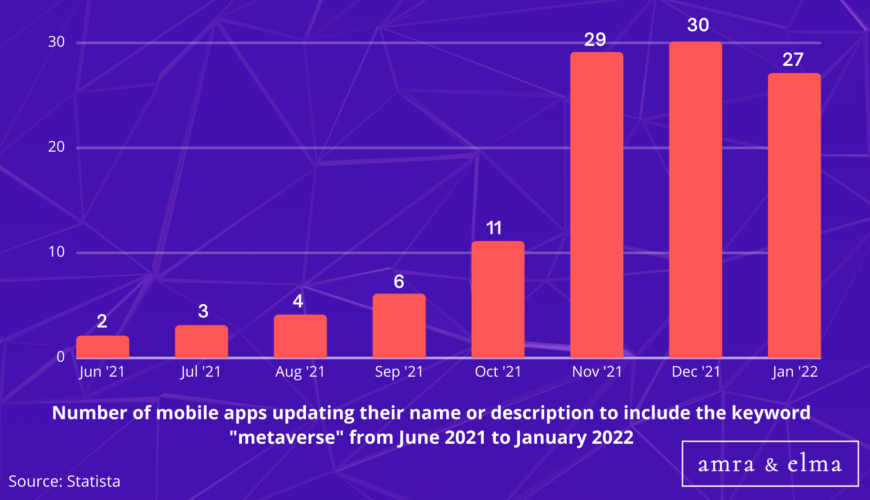
Metaverse Statistics #14: In 2022, there will be an estimated 1.1 billion mobile AR users worldwide.
According to a research from Statista, the number of mobile AR users worldwide is expected to reach 1.7 billion by 2024, a significant increase from the 200 million seen in 2015. In 2022, there will be an estimated 1.1 billion mobile AR users worldwide. Mobile AR refers to the use of AR technology on mobile devices, such as smartphones and tablets. This technology allows users to superimpose digital content onto the real world, providing an immersive experience. The growing popularity of mobile AR is driven by the increasing availability of AR-enabled devices and applications. Major tech companies, such as Apple and Google, are investing heavily in this technology, and it is expected to become increasingly mainstream over the next few years.

Metaverse Statistics #15: In 2020, 83.7 million people used AR at least once per month in the United States.
According to a recent report from Statista, the number of virtual reality (VR) and augmented reality (AR) users in the United States is expected to grow significantly in the next few years. In 2017, there were 29.4 million AR users in the US, with a significant increase to 83.7 million in 2020. By 2023, the total number of AR users is expected to exceed 110 million. The increase in VR and AR usage can be attributed to the growing popularity of these technologies in both the consumer and commercial sectors. In the consumer sector, VR and AR are being used for gaming, entertainment, and education, while in the retail industry, they are being adopted for training, marketing, and product design. With more businesses and individuals using VR and AR for various purposes, the number of users will likely continue to grow in the future.

Metaverse Statistics #16: In 2021, 32% of surveyed respondents indicated that they are using VR daily in the U.S.
According to a recent data report from Statista, the number of virtual reality (VR) users in the United States who are using VR on a daily basis has increased significantly over the past few years. In 2018, only 15 percent of respondents indicated they were using VR daily, while in 2021, 32 percent of respondents indicated that they are using VR daily. This increase can be attributed to a number of factors, including the introduction of more affordable and user-friendly VR headsets, the increasing popularity of gaming and entertainment applications, and the growing awareness of the potential for VR to be used for training and education purposes. With the continued advancement of VR technology, it is likely that the number of daily VR users will continue to increase in the years to come.

Metaverse Statistics #17: XR/AR/VR/MR global market reached 28 billion U.S. dollars in 2021.
According to a recent data report from Statista, the global augmented reality (AR), virtual reality (VR), and mixed reality (MR) market reached 28 billion U.S. dollars in 2021. The report predicts that this figure will rise to over 250 billion U.S. dollars by 2028, an increase of nearly 800 percent in just seven years. These trends are being driven by the rapidly falling cost of AR/VR/MR hardware and the increasing availability of high-quality content. As a result, businesses in a wide range of industries are beginning to explore how these technologies can be used to improve their products and services. For instance, retailers are using AR/VR/MR to create immersive shopping experiences, while healthcare providers are using these technologies to provide patients with more realistic simulations of medical procedures. With the market for AR/VR/MR expected to continue its rapid growth in the coming years, it is clear that these technologies are poised to have a major impact on the way we live and work.

Metaverse Statistics #18: Worldwide shipments of extended reality (XR) headsets stood at seven million in 2020.
According to a report from Statista, worldwide shipments of extended reality (XR) headsets stood at seven million in 2020. This is a huge increase from only 1.2 million in 2017. The number of shipments is forecasted to increase even further to 105 million by 2025. This indicates that AR and VR headsets are expected to transform the way users experience media, software applications, and social networking. Some of the headset manufacturers that are driving this market growth include Oculus VR, HTC Vive, and Sony PlayStation. These companies are continuously innovating and developing new technologies that will enhance user experiences. For example, Oculus VR has developed a hand-tracking technology that allows users to interact with virtual objects without the need for controllers. This natural way of interacting with virtual content is expected to attract more users to XR headsets. In addition, Oculus VR is also working on a standalone headset called the Quest 2 that does not require a PC or gaming console to operate, which makes it more accessible to a wider range of users. With such advancements in technology, it is no wonder that the XR headset market is forecasted to grow tremendously in the next few years.
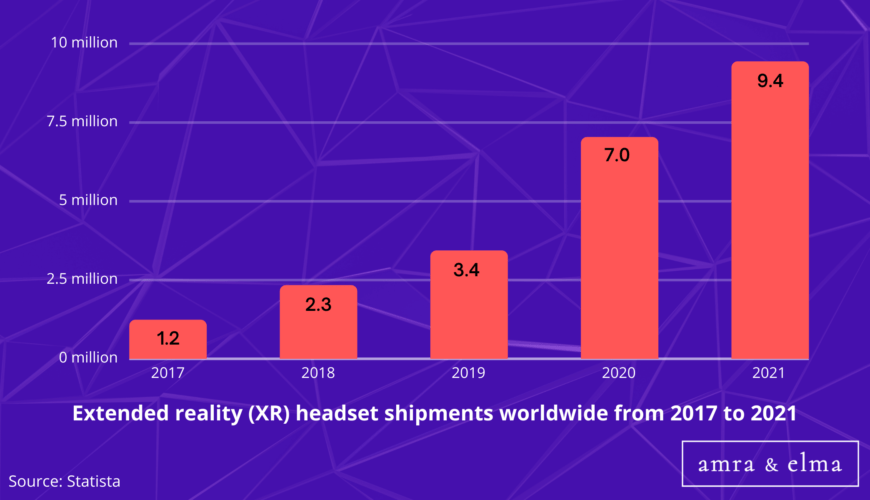
Metaverse Statistics #19: JP Morgan has predicted that the market size of metaverse will increase to $1 trillion in the future.
According to EnterpriseAppsToday, JP Morgan is known to be the first bank to set up a metaverse office space. Everyrealm has developed a shopping district known as ‘Metajuku’ on Decentraland, a digital space where JP Morgan owns its metaverse lounge. As per the officials, the bank will soon offer services such as credits, mortgages, and rents via their metaverse lounge. The move is seen as an effort by the bank to explore new frontiers in the world of digital banking and open up new avenues of business. With the help of blockchain technology, JP Morgan plans to provide a secure and efficient way for customers to access banking services via the metaverse. This move is sure to revolutionize the way we think about banking and could pave the way for a new era of digital finance.

Metaverse Statistics #20: Facebook has invested more than $10 billion in metaverse technology.
Facebook has recently renamed its social network ‘Meta’. It has spent around $50 million on some non-profit funding groups to develop metaverse technologies. Meta’s Reality Labs division has invested around $10 billion in the metaverse, the next generation internet, which is 10 times more what Facebook has spent to buy Instagram and 5 times more money that has been spent to buy the Oculus VR business. With this level of investment, it is clear that Facebook is serious about developing the metaverse and becoming a major player in this emerging technology. While the metaverse is still in its early stages of development, it has the potential to revolutionize the way we interact with the internet and could have a major impact on our lives in the future. (source: EnterpriseAppsToday)
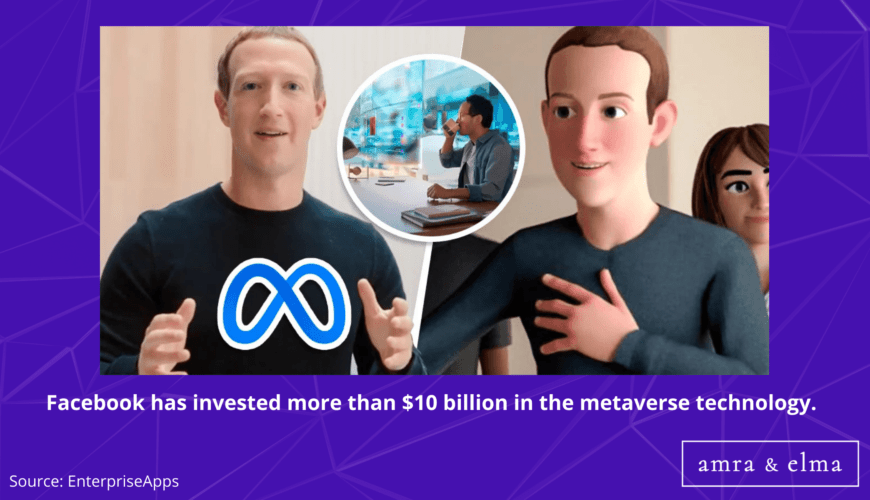
Metaverse Statistics #21: Microsoft has signed a deal worth $22 billion for mixed reality technology.
According to EnterpriseAppsToday, the tech giant Microsoft has signed a deal with the US army worth $21.8 billion. The company will deliver 120000 AR headsets to the US army. In 2018, Microsoft and the US army have signed a contract worth $480 million to manufacture over 100000 HoloLens headsets. This is not the first time that Microsoft has partnered with the US military. The company has been providing software and hardware to the Pentagon for many years. However, this is the first time that it has been contracted to provide such a large number of AR headsets. The HoloLens is a cutting-edge piece of technology that has a wide range of potential applications. For example, it can be used for training, simulation, and even battle planning. The US military is clearly betting big on the potential of AR, and Microsoft is poised to profit handsomely from this trend.
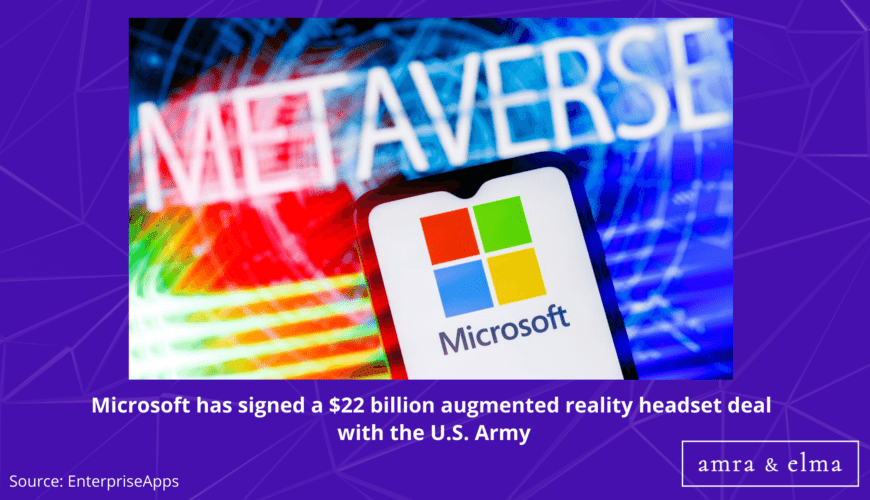
Metaverse Statistics #22: Epic Games has made $1 billion for metaverse strategies.
According to metaverse statistics for 2021, Epic Games has made one of its main funding for metaverse worth $1 billion. The market size of Epic Games has reached $28 billion. Sony as well has invested around $200 million in Epic games to be its close allies. These investments will help to bring the idea of a metaverse closer to reality and give users a more immersive experience. In addition, it will also help to create a more competitive environment for developers and encourage innovation. The metaverse is still in its early stages of development, but with the support of major companies like Epic Games and Sony, it has the potential to become a major force in the gaming industry and amongst Youtube gamers.
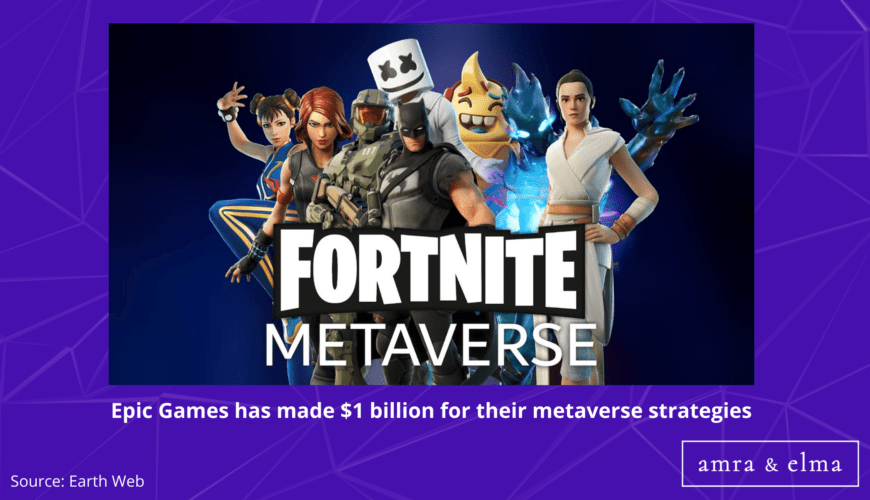
Metaverse Statistics #23: Facebook will create around 10000 jobs in the next five years via metaverse.
Meta, the social media giant, has announced that it will create 10000 jobs in Europe over the next five years. The company will focus on Germany, Spain, Italy, France, Ireland, Poland, and the Netherlands to fill these job positions. This move comes as part of Meta’s plans to create a metaverse setting. In a metaverse setting, people can interact with each other and experience different virtual worlds. This will require a large number of workers to create and maintain the Metaverse. The company is confident that these job positions will be filled by talented and skilled workers from the European market. This is a great opportunity for those looking for a job in the tech industry. (source: Meta NewsRoom)
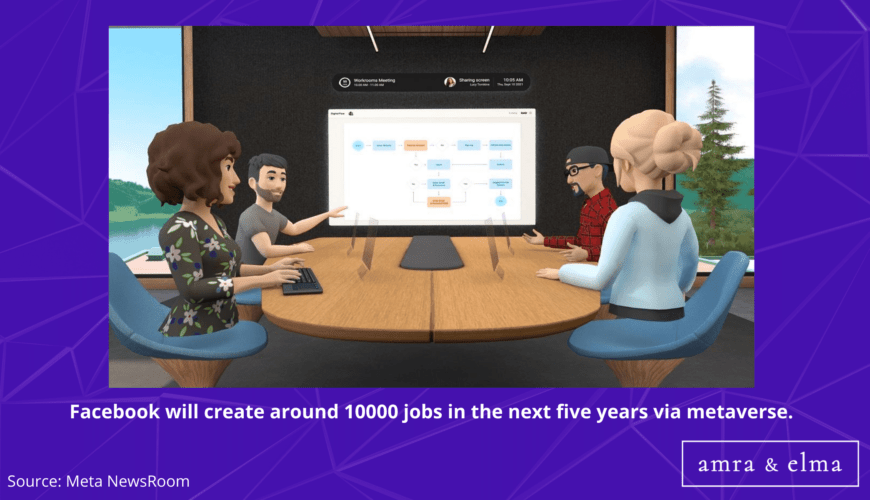
Metaverse Statistics #24: Roblox players spent $652 million on the site’s virtual currency, Robux.
According to the New York Times, in the first quarter of 2021 people spent almost 10 billion hours playing Roblox and over 42 million users logged in each day. Players spent almost $652 million on the site’s virtual currency, Robux, which can be used to buy digital items for their characters. Roblox is a social networking platform that allows users to create and share their own games. The company has been profitable since 2016, and it went public in March of this year. The success of Roblox is due in part to its focus on safety and security; the platform has a team of moderators who monitor content and remove anything that violates the site’s terms of service. In addition, Roblox offers parents a way to limit their children’s interactions with other users. The popularity of Roblox demonstrates the growing demand for social gaming experiences. As more people seek out ways to connect with others online, it is likely that platforms like Roblox will continue to thrive.

Metaverse Statistics #25: 45.8 million people watched “Astronomical” virtual concert by Travis Scott.
It’s no secret that the pandemic has forced many people indoors and drastically changed the way we interact with one another. But while some industries have suffered as a result of the quarantine, others have managed to adapt and even thrive. This is certainly true in the music industry, where virtual concerts have become increasingly popular. Thanks to platforms like Roblox and Fortnite, musicians have been able to reach a wider audience than ever before. In fact, Travis Scott’s recent virtual concert “Astronomical” on Roblox drew in an impressive 45.8 million viewers. Similarly, 33 million people tuned in to watch Lil Nas X’s recent virtual concert on Roblox. Clearly, virtual concerts are here to stay, at least for the foreseeable future. And given their popularity, it’s likely that we’ll see even more innovative uses of this technology in the months and years to come.

Conclusion
As we have seen, the metaverse is a rapidly growing and evolving digital landscape. As more people around the world gain access to high-speed internet, the opportunities for businesses and individuals to engage in virtual worlds will continue to increase. The research conducted in this report provides valuable insight into the current state of the metaverse and its potential future development. With an understanding of the size and scope of the metaverse, businesses can better assess the opportunities and threats posed by this ever-changing digital landscape.
TOP METAVERSE STATISTICS FOR 2023- FAQ’s:
How fast is metaverse growing?
The metaverse is growing rapidly. The global metaverse market size reached USD 63.08 Billion in 2021 and is expected to reach USD 1607.12 Billion in 2030, registering a CAGR of 43.3%.
Is the metaverse popular?
The metaverse is popular in some circles. It’s a hot topic of discussion among futurists, technologists, and science fiction fans. Some believe that the metaverse will eventually become an integral part of our lives, transforming how we live, work, and play. Others are skeptical, arguing that the metaverse is nothing more than a glorified chat room or gaming platform. Regardless of where you stand on the issue, there’s no denying that the metaverse is an intriguing concept with much potential.
What is metaverse?
Metaverse is a hypothetical iteration of the Internet as a single, universal and immersive virtual world that is facilitated by the use of virtual reality (VR) and augmented reality (AR) headsets.
What is the market size of the metaverse?
The market size of metaverse reached USD 63.08 Billion in 2021. The metaverse market is projected to grow from $478.7 billion in 2020 to $783.3 billion in 2024, at a CAGR of 13.1%.
What is the meaning of metaverse?
The meaning of metaverse was coined in Neal Stephenson’s 1992 science fiction novel Snow Crash to describe a future digital world in which people could interact with each other and create and share content. The meaning of metaverse represents a digital world that sits on top of the physical world and allows for interactions that are not possible in the real world. For example, in the core meaning of metaverse, you could create a virtual representation of yourself that can be customized however you want and can interact with other people’s virtual representations. You could also create and share content, such as videos, music, articles, etc., that can be viewed by other people in the basic meaning of metaverse.
The meaning of metaverse is different from the internet in that the internet is a collection of websites and digital content that can be accessed by computers. The meaning of metaverse represents a digital world where people can interact with each other and create their content. The internet is a tool that can be used to access the metaverse, but the meaning of metaverse is not limited to the internet.
Today, the meaning of metaverse is often used to describe any online virtual world, such as Second Life or World of Warcraft. These worlds allow users to create avatars that represent themselves and interact with other users in a virtual environment. The meaning of metaverse can be seen as an extension of the real world, as it allows people to explore different cultures and socialize with other people from around the world.
Why is metaverse important?
The meaning of metaverse is used in several different ways, but in general, it refers to a virtual world or digital universe which is composed of multiple user-created online spaces, or “dimensions.” It can also refer to the software that enables users to access these dimensions. In some cases, it may also refer to the actual servers and networks that host these virtual worlds.
Metaverse is often compared to the internet, but there are some key differences. Metaverse is not just a collection of websites, it is its complete world with its own rules, physics, and societies. Users can create their objects and environments and can interact with other users in real time. Metaverse worlds can be based on any theme or genre, from fantasy to sci-fi to contemporary life.
One of the most popular uses of metaverse technology is for online gaming. There are now hundreds of MMORPGs (massively multiplayer online role-playing games) that allow players to explore rich and detailed virtual worlds together. But metaverse technology can be used for much more than just gaming. It has been used for education, business collaboration, social networking, and many other purposes.
The potential for metaverse technology is still being explored, and, likely, we have only scratched the surface of its possibilities. Some futurists believe that the metaverse will eventually become the primary way we interact with the digital world, replacing websites, apps, and other traditional digital media.
Metaverse is important because it is the first platform to combine blockchain technology with virtual reality. This means that users can interact with each other in a virtual world that is secured by blockchain technology. This makes Metaverse unique because it offers a new way for people to interact with each other online.
In addition, Metaverse also offers a variety of features that allow users to create and own digital assets. These features include:
- An asset creation platform that allows users to create and issue digital assets
- A digital identity system that allows users to create and manage their identities
- A smart contract system that allows users to create and execute contracts
How to use Metaverse?
When thinking about how to use Metaverse, we have to first understand what Metaverse is. Metaverse is a decentralized platform that enables users to create and manage digital assets and identities, and it allows for the creation of smart contracts and provides a user-friendly interface to allow for the easy management of digital assets. Before learning how to use Metaverse, we need to recognize that is built on blockchain technology and uses BitShares’ consensus mechanism, Delegated Proof of Stake (DPOS), to ensure security and reliability.
When understanding how to use Metaverse, you first need to create an account. Once you have created an account, you can then create a wallet to store your digital assets. There are many ways to create a wallet on the platform if you want to know how to use Metaverse, but the easiest way is to use the Metaverse client. The client can be downloaded from the Metaverse website and it is available for Windows, Mac, and Linux.
Once you have created a wallet, to learn how to use Metaverse properly, you can start to add digital assets to it. There are many ways to add digital assets to your wallet, but the easiest way is to use the Metaverse client. The client allows you to import private keys or scan a QR code with your phone to add digital assets.
Once you have added some digital assets to your wallet, you can then start using them, which is a crucial component of learning how to use Metaverse. One way to use your digital assets is to send them to other users on the network. To do this, you need the recipient’s public key address. You can also use your digital assets to create smart contracts. Smart contracts are agreements between two or more parties that are stored on the blockchain and are executed automatically when certain conditions are met.
Metaverse is a decentralized platform that enables users to create and manage digital assets and identities, and if you want to learn how to use Metaverse, these are the primary steps. Metaverse allows for the creation of smart contracts and provides a user-friendly interface to allow for the easy management of digital assets.

